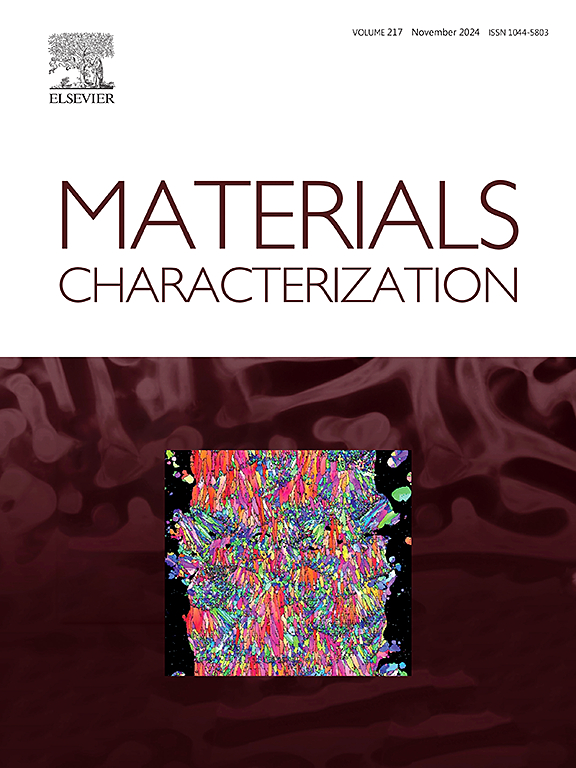热等静压SiCf/Ti2AlNb复合材料中O相的演化
IF 4.8
2区 材料科学
Q1 MATERIALS SCIENCE, CHARACTERIZATION & TESTING
引用次数: 0
摘要
连续SiC纤维增强Ti2AlNb复合材料(SiCf/Ti2AlNb)的基体微观结构是决定其力学性能的关键因素。了解基体中O相析出和演化的机制对于优化工艺参数和提高复合材料性能至关重要。在本研究中,SiCf/Ti2AlNb复合材料是通过制备基体涂层SiC纤维的前驱丝,然后通过热等静压(HIP)进行固结制备的。系统地表征了前驱丝和复合基体的微观结构,包括形貌、含量、晶粒尺寸和相演化。结果表明:前驱丝基体中含有纳米级的O相、B2相和α2相,其中O相的相对含量最高;磁控溅射过程诱导了纳米级O、α2和B2相之间特定的取向关系。在三相区(O + B2 + α2)进行HIP处理后,复合基体中出现了微尺度的O、B2和α2相。O相的相对比例最低。复合材料中O相的转变经历了以下三个过程:(1)α2相由于铌的扩散由α2→α2(贫铌)+ O(富铌)转变;(2)在高温下,B2相通过元素扩散转变为O相,但B2相的部分区域不析出为O相;(3)前驱丝中的O相生长转变为α2和B2相,保留部分未转变的O相。O相是Ti2AlNb基体中重要的强化相。然而,复合材料基体中O相的含量相对较低,通过HIP加工或热处理调节其含量是提高复合材料性能的潜在方法。本文章由计算机程序翻译,如有差异,请以英文原文为准。
Evolution of the O phase in SiCf/Ti2AlNb composites fabricated by hot isostatic pressing
The matrix microstructure of continuous SiC fiber-reinforced Ti2AlNb composites (SiCf/Ti2AlNb) plays a critical role in determining their mechanical properties. Understanding the mechanisms behind the precipitation and evolution of the O phase in the matrix is crucial for optimizing processing parameters and enhancing composite performance. In this study, SiCf/Ti2AlNb composites were fabricated by preparing precursor wires from matrix-coated SiC fibers, followed by consolidation via hot isostatic pressing (HIP). The microstructure of both the precursor wires and the composite matrix including morphology, content, grain size, and phase evolution were systematically characterized. Results show that the precursor wire matrix contained nanoscale O, B2, and α2 phases, where the O phase had the highest relative percentage. The magnetron sputtering process induced a specific orientation relationship between the nanoscale O, α2, and B2 phases. After HIP processing in the three-phase region (O + B2 + α2), microscale O, B2, and α2 phases were observed in the composite matrix. The O phase exhibited the lowest relative percentage. The O phase in the composites undergoes transformation through the following three processes: (1) The α2 phase transforms from α2 → α2 (Nb-lean) + O (Nb-rich) due to niobium diffusion; (2) the B2 phase transforms into the O phase through elemental diffusion at high temperatures, although some regions of the B2 phase do not precipitate into the O phase; (3) the O phase in the precursor wires grows and transforms into α2 and B2 phases, with some untransformed O phase being retained. The O phase is a key reinforcing phase in the Ti2AlNb matrix. However, the content of the O phase in the composite matrix is relatively low, making the regulation of its content through HIP processing or heat treatment a potential method for enhancing the composite's performance.
求助全文
通过发布文献求助,成功后即可免费获取论文全文。
去求助
来源期刊

Materials Characterization
工程技术-材料科学:表征与测试
CiteScore
7.60
自引率
8.50%
发文量
746
审稿时长
36 days
期刊介绍:
Materials Characterization features original articles and state-of-the-art reviews on theoretical and practical aspects of the structure and behaviour of materials.
The Journal focuses on all characterization techniques, including all forms of microscopy (light, electron, acoustic, etc.,) and analysis (especially microanalysis and surface analytical techniques). Developments in both this wide range of techniques and their application to the quantification of the microstructure of materials are essential facets of the Journal.
The Journal provides the Materials Scientist/Engineer with up-to-date information on many types of materials with an underlying theme of explaining the behavior of materials using novel approaches. Materials covered by the journal include:
Metals & Alloys
Ceramics
Nanomaterials
Biomedical materials
Optical materials
Composites
Natural Materials.
 求助内容:
求助内容: 应助结果提醒方式:
应助结果提醒方式:


